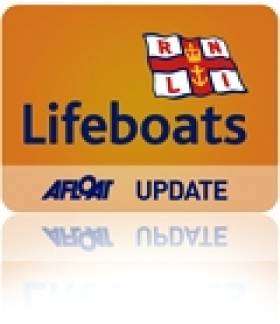Displaying items by tag: Owen Medland
Ballycotton Lifeboat Honours Mechanic
Michael has become well known throughout the RNLI community over the years and the 29 January was marked on several calendars for quite some time as the date they would be travelling to Ballycotton to help celebrate the retirement of an exceptional, modest man.
Lifeboat personnel travelled from RNLI lifeboat stations in Ballyglass Co. Mayo, Achill Island, Courtmacsherry, Rosslare, Helvic and Youghal joining with Ballycotton lifeboat members, family and friends to help celebrate a man's commitment to a job he treated more as a vocation than a job. The Training Divisional Inspector, Owen Medland and Divisional Base Manager, Derek Potter from the RNLI head quarters in Dublin attended and spoke of their long association with Michael Lane Walsh. Several presentations were made with the good wishes from everyone present, along with those from lifeboat crewmembers who were unable to leave their stations. Derek Potter told those present that normally they would be presenting a long service vellum to the retiree but in Michael's case he is not finished yet. For the time being he will not be hanging up his life jacket but will keep it in readiness for the next time someone calls for help from the Ballycotton RNLI lifeboat.
Related Safety posts
RNLI Lifeboats in Ireland
Safety News
Rescue News from RNLI Lifeboats in Ireland
Coast Guard News from Ireland
Water Safety News from Ireland
Marine Casualty Investigation Board News
Marine Warnings
Enniskillen and Baltimore Busiest Irish Lifeboats, Launching Five Times a Day in Summer
Preliminary figures* for summer 2010, issued today (22 September) by the Royal National Lifeboat Institution (RNLI), show the charity's Irish lifeboats launched on average five times every day during June, July and August.
RNLI lifeboats were requested to launch 450 times during June, July and August. The busiest station in Ireland was Enniskillen in Fermanagh with 29 launches followed by Baltimore in West Cork with 23 callouts. Fifty-four of those launches were in Dublin at lifeboat stations in Dun Laoghaire (22), Howth (20) and Skerries (12). Read more about the year's lifeboat rescues in 2010 HERE
The figures come on the back of a significant investment by the charity in the Irish lifeboat fleet. New inshore lifeboats have been put on service in Dun Laoghaire, Kilrush in Clare and Fenit in Kerry. These new lifeboats are fast, efficient and technically equipped to reach casualties faster and to provide increased cover around the coast.
Commenting on the RNLI summer lifeboat launches, RNLI Training Divisional Inspector, Owen Medland, said, 'It has been a busy Summer for Irish lifeboat crews. Over the course of those three months there have been a number of dramatic and challenging callouts for our volunteers. This summer RNLI Sea Safety volunteers have run a number of lifejacket clinics and flare demonstrations around the coast and at inland waterways to advise all water users on how to stay safe on the water.'
RNLI Operations Director, Michael Vlasto, added: 'The summer is always busy as more and more people opt to relax at the coast. The figures show that our volunteers are called on much more during this time and the fact they respond every time the pager goes off shows just how committed they are to saving lives at sea.
'Many of our lifeboat volunteers are also particularly busy at this time with their day jobs as many of them work in the tourism industry, so we are especially grateful to them in summer – and to their employers who allow them to stop work at the "bleep of a pager" to help others, and given the current economic climate for businesses this is a great contribution to the charity.'
Read more about the year's lifeboat rescues in 2010 HERE
Related Safety posts
RNLI Lifeboats in Ireland
Safety News
Rescue News from RNLI Lifeboats in Ireland
Coast Guard News from Ireland
Water Safety News from Ireland
Marine Casualty Investigation Board News
Marine Warnings































































